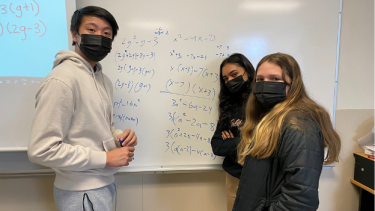
Learning to Understand
What if you could lower student anxiety while increasing their confidence? At the start of my teaching career, high school math classrooms were typically quiet rooms unless the teacher was talking where they stood and delivered content. This has changed over the years, and the practice has changed to better support student engagement, deeper thinking, and collaboration.
Students often find math a challenging subject that can cause stress and anxiety. Inspired by Peter Liljedahl’s Thinking Classroom, I had whiteboards installed on my classroom walls. Due to the temporary erasable nature of whiteboards, students are more inclined to take risks and start seeing mistakes as part of the learning process, thereby increasing student confidence. Students find it easier to start solving problems, discussing, and participating as a classroom community of learners. Collaboration and risk-taking have increased significantly as student anxiety towards math has decreased.
Since implementing the whiteboards, I have noticed improved student engagement, collaboration, and higher-level reasoning. Another significant change has been the increased use of student pairing. Students have a single marker between them taking turns in the role of the student and the guide. While one student works on the problem, the other guides and checks their work, talking themselves through any difficulties as they co-construct their learning.
Students discuss problem-solving strategies with each other, engaging in reflexive learning. By pairing students randomly using playing cards, students develop new relationships and experience a variety of learning styles, gradually creating a relational learning community. Once paired, students work on problems at the board. Differentiation is straightforward as partners can progress through at their own pace, and I can easily assign problems of greater depth to mathematically inclined students while providing extra support for those who need it. Students are becoming more comfortable with the time and persistence necessary to solve higher level problems.
Another change I have made is increasing student reflection. Learning portfolios (see example), journals, and other reflection techniques help students better understand their learning and connect various mathematical concepts. Students work on inquiry projects in a variety of formats such as web pages, slideshow presentations, and even videos. These changes have impacted student well-being and mental health as there is a changed tone and feel in my classroom. This is particularly true for students who previously struggled in math or have hesitated to participate. I have found students to be remarkably positive and encouraging towards each other as they learn and practice these competencies together and look forward to their learning journey ahead!